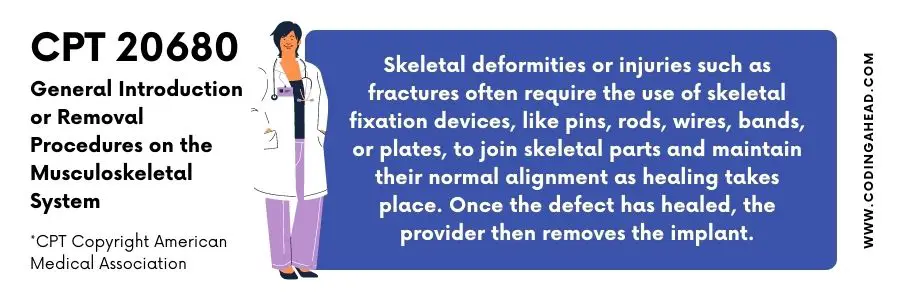(2023) CPT Code 20680 | Description, Billing Guidelines, Modifiers & Examples
CPT code 20680 is coded for removing a deep implant. This article contains an in-depth description of CPT 20680, followed by easy to follow billing guidelines, modifiers and examples of when this code is used.
Introduction
If you want to eliminate a single implant system or construction that may need several incisions, you should utilize code 20680.
The code 20680 defines a service usually only documented once—for example, an intramedullary [IM] nail and several locking screws.
Skeletal fixation devices, such as pins, rods, wires, bands, or plates, are commonly required when dealing with skeletal anomalies or injuries, such as fractures.
The healthcare professional then removes the implant after the wound has healed.
No matter how many screws, plates, or rods have been implanted or incisions have been made to remove them.
Description Of The CPT Code 20680
The official description CPT code 20680 is: “Removal of implant; deep (eg, buried wire, pin, screw, metal band, nail, rod or plate).”
Due to significant changes in physician work for removing deep implants due to technological improvements, the RUC recognized that the intra-operative time for Procedure code 20680 is overstated.
Therefore, work RVU 5.86 was recommended by the RUC based on the survey’s 25% value for intra-service time and the 25% value for work RVUs, modified to account for the fact that this surgery typically takes place in an outpatient setting.
A more complex multilayer closure is required for CPT code 20680 since the surgeon must incise through the muscle layers and into the bone.
To remove the implant, the surgeon first makes an incision on the top of the implant region and then employs deep dissection to get a clear view.
The wound is often patched using stitches, staples, and other medical equipment.
It is possible to classify the removal of deep pins (CPT code 20680).
An implant dissection happens when the surgeon creates an incision over the implant site and then uses specialized equipment to remove the implant, which is often concealed under the surface of the bone.
Layers of sutures, staples, and other materials heal the wound.
Pin or K-wire removals that don’t need a multilayer closure are coded as 20670 (such as K-wire removals).
Remove an Ankle Implant process code 27704 instead of procedure code 20670 or CPT code 20680 to remove ankle hardware.
If just one or two screws are removed, use the appropriate 20670 or CPT code 20680 number instead of the 27704 code for more extensive or extended treatment.
When removing a finger or hand implant, CPT code 26320 should be used.
Enter the appropriate 20670 or CPT code 20680 number if just one or two screws are removed and the procedure is short.
Codes 24160-24164 should be used to bill for removing an implant from the elbow or radial head. You should use the proper code for the duration of the operation rather than the 20670 or CPT code 20680.

Billing Guidelines
Both the CPT Assistant and the American Academy of Orthopedic Surgeons recommend against billing the CPT code 20680 code more than once per fracture site.
The 20680 CPT code must be used twice because the hardware must be removed from an unrelated location to the initial fracture site or portion of the damage.
Therefore, the number of hardware removals or incisions needed to remove the hardware from only one fracture site (or injury site) should not be considered once billing this code.
As 20680 CPT code, use Procedure Code 27704, which explains the removal of an ankle implant, to describe the removal of the implant.
If just one or two screws need to be removed, use the CPT 20680 instead of the 27704 number.
Modifiers
Multiple submissions of CPT code 20680 need to remove the damaged hardware to treat a fresh, unconnected fracture (e.g., ankle and wrist hardware).
With Modifier 59, Distinct Procedural Service, implant removal may be achieved. You may need modifier 59 when two or more CPT codes not typically reported together are performed simultaneously.
- Various sessions
- Various procedures or surgeries
- Incision and excision are done separately.
A different site or organ system: According to the National Correct Coding Initiative (CCI) standards, this condition “does not encompass treatment of neighboring structures of the same organ.”
“Treating the nail, nail bed, and nearby soft tissue, for example, is treating a single anatomic location.
Likewise, treating the ipsilateral eye’s posterior segment structures represents treating a single anatomic location.
Treatment of a single anatomic location includes arthroscopic treatment of a shoulder injury in adjacent regions of the ipsilateral shoulder.”
“Use of modifier 59 to signify distinct procedures/surgeries does not necessitate a new diagnosis for each HCPCS/CPT coded procedure/surgery,” according to Chapter 1 CCI standards.
Furthermore, varied diagnoses are poor conditions for using modifier 59.
Therefore, unless the procedures/surgeries are done at distinct anatomic locations or in separate patient encounters, the HCPCS/CPT codes remain bundled.”
CPT Code 20680 Examples
The following are examples of when the 20680 CPT code may be used.
Example 1
A surgical incision may be made between the lateral malleolus (distal fibula) and medial malleolus (tibia), and both screws are removed.
The only concern was two fractures, and removing the implants was not a determining factor in the outcome.
Example 2
It is not permitted to use the CPT code 20680 more than once after removing an intramedullary rod (IM rod).
In this case, however, because the rod is supplied with locking screws on both ends, a single incision may be required to release the screws; this is still considered a single implant device for treating a single fracture site.
In addition, treating a single anatomic location includes arthroscopic treatment of a shoulder injury in adjacent areas.
Therefore, only a single instance of the CPT code 20680 is necessary.



